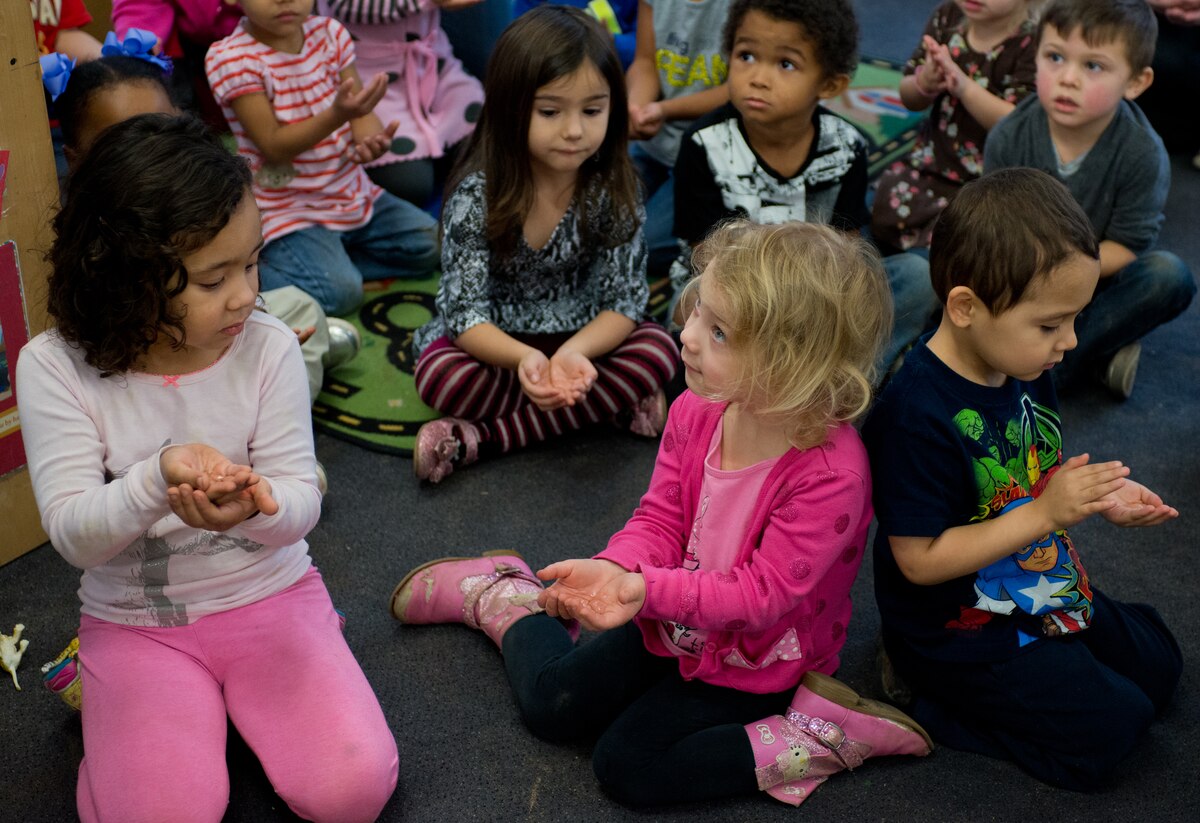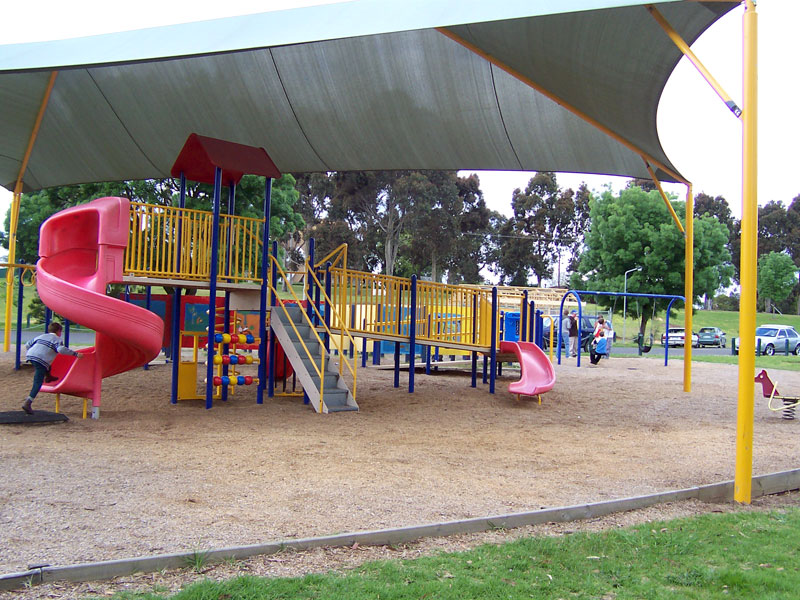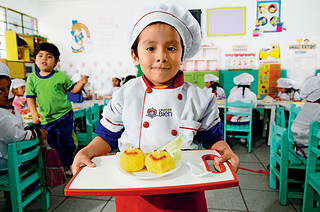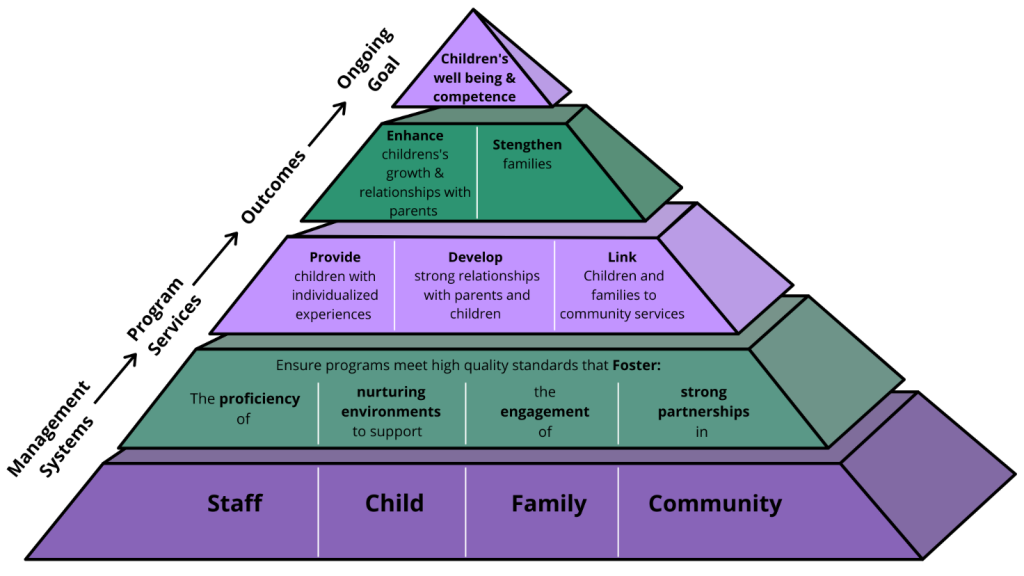1 Children’s Well-Being
Focus on Wellness
A culture of wellness exists when staff and child health and safety are valued, supported, and promoted through health & wellness programs, policies, and environment.[1]
Learning Objectives
At the end of this chapter, you should be able to:
- Explain the importance of health and well-being in early childhood.
- Describe the qualities and benefits of high-quality early care and education programs.
- Outline what the book will address regarding safety, health, and nutrition.
- Discuss what licensing is and its role in keeping children safe and healthy.
INtroduction
Evidence shows that experiences in childhood are extremely important for a child’s healthy development and lifelong learning. How a child develops during this time affects future cognitive, social, emotional, language, and physical development, which in turn influences school readiness and later success in life. Research on several adult health and medical conditions points to pre-disease pathways that begin in early and middle childhood.

During early childhood, the human brain grows to 90 percent of its adult size by age 3. Early childhood represents the period when young children reach developmental milestones that include:
- Emotional regulation and attachment
- Language development
- Cognitive development
- Physical development (motor skills)
All these milestones can be greatly delayed when young children experience inadequate caregiving, environmental stressors, and other negative risk factors. These stressors and factors can affect the brain and may seriously compromise a child’s physical, social-emotional, and cognitive growth and development.
More than any other developmental periods, childhood sets the stage for:
- School success
- Health literacy
- Self-discipline
- The ability to make good decisions about risky situations
- Eating habits
- Conflict negotiation and healthy relationships with family and friends[2]
Overview of Chapters in this Book
This book is divided into three sections:
- Health
- Safety
- Nutrition
Health
Chapters 1 – 6 focus on the overall physical and mental health of young children. “Health is more than merely the absence of disease—it is an evolving human resource that helps children and adults adapt to the challenges of everyday life, resist infections, cope with adversity, feel a sense of personal well-being, and interact with their surroundings in ways that promote successful development.”[3]

As mentioned at the beginning of the chapter, research is showing that many adult health issues, such as high blood pressure, heart disease, and diabetes, are linked to what happens during early childhood (and even prenatally!). We also know that during early childhood there are biological systems that are more sensitive to environmental factors (such as child maltreatment, malnutrition, and recurring issues to infectious disease).[4]
It is vital for children and their families to have support for children’s physical, oral, and mental health. This happens through promoting health and protection from illness.
Safety
Chapters 7 – 11 focus on the policies and regulations intended to keep children safe, both indoors and outdoors as well as recognizing signs of abuse and

neglect. Children are curious and eager to learn. They depend on their caregivers to keep them safe by making sure that nothing within a child’s reach can harm them. Injuries are a serious health risk to young children. But most injuries are predictable and preventable.[5]
ECE programs can prevent risks and unnecessary harm to children by committing to a culture of safety. A culture of safety prioritizes safety at all levels. It encourages programs to learn from past problems and prevent them in the future.[6] Programs should not assume that nothing will ever go wrong. In fact, they should plan that something is going to go wrong. And their goal is to make it as hard as possible for things to go wrong.[7]
Nutrition
Chapters 12 – 15 focus on nutrition for young children. Healthy eating and being active are essential to a child’s well-being. Children who are under- or over-nourished are at risk for chronic health problems.[8] Early childhood is an important time for developing healthy habits for life. Children’s bodies grow and develop in ways that affect the way they think, eat, and behave.[9]

A healthy diet not only affects growth, but also immunity, intellectual capabilities, and emotional well-being. Families and educators must ensure that children receive an adequate amount of needed nutrients to provide a strong foundation for the rest of their lives.[10]
Understanding Childhood Health Concerns
Although young children are typically healthy, it is during this time that they are at risk for conditions such as:

- Developmental and behavioral disorders
- Child maltreatment
- Asthma and other chronic conditions
- Obesity
- Dental caries (cavities)
- Unintentional injuries
While typically nonfatal, these conditions affect children, their education, their relationships with others, and the health and well-being of the adolescents and adults they will become.[11]
Emerging Issues in Childhood Health
The keys to understanding childhood health are recognizing the important roles these periods play in adult health and well-being and focusing on conditions and illnesses that can seriously limit children’s abilities to learn, grow, play, and become healthy adults.
Prevention efforts in early and middle childhood can have lasting benefits. Emerging issues in early and middle childhood include implementing and evaluating multidisciplinary public health interventions that address social determinants of health by:
- Fostering knowledgeable and nurturing families, parents, and caregivers
- Creating supportive and safe environments in home, schools, and communities
- Increasing access to high-quality health care[12]
Impacts of Stress on Early Childhood Development
Early childhood, particularly the first 5 years of life, impacts long–term social, cognitive, emotional, and physical development. Healthy development in early childhood helps prepare children for the educational experiences of kindergarten and beyond. Early childhood development and education opportunities are affected by various environmental and social factors, including:
- Early life stress
- Socioeconomic status
- Relationships with parents and caregivers
- Access to early education programs
Early life stress and adverse events can have ongoing impacts on the mental and physical health of children. Specifically, early life stress can contribute to developmental delays and poor health outcomes in the future. Stressors such as physical abuse, family instability, unsafe neighborhoods, and poverty can cause children to have inadequate coping skills, difficulty regulating emotions, and reduced social functioning compared to other children their age.
Additionally, exposure to environmental hazards, such as lead in the home, can negatively affect a child’s health and cause cognitive developmental delays. Research shows that lead exposure disproportionately affects children from minority and low–income households and can adversely affect their readiness for school.
The socioeconomic status of young children’s families and communities also significantly affects their educational outcomes. Specifically, poverty has been shown to negatively influence the academic achievement of young children. Research shows that, in their later years, children from disadvantaged backgrounds are more likely to need special education, repeat grades, and drop out of high school. Children from communities with higher socioeconomic status and more resources experience safer and more supportive environments and better early education programs.
|
|
|
 |
The Effects of Poverty on Education “Despite being one of the most developed countries in the world, the United States has one of the highest rates of childhood poverty globally.”[13] “Poverty has a particularly adverse effect on the academic outcomes of children, especially during early childhood.”[14] Research has shown that children from families in poverty enter school with a readiness gap. Contributions to this gap include:
Two additional things that are important to note:
|
Value of Quality Early Childhood Education
Early childhood programs are a critical outlet for fostering the mental and physical development of young children. According to the Center on the Developing Child at Harvard University’s A Science-Based Framework for Early Childhood Policy, “The principal elements that have consistently produced positive impacts include: highly skilled teachers; small class sizes and high adult-to-child ratios; age-appropriate curricula and stimulating materials in a safe physical setting; a language-rich environment; warm, responsive interactions between staff and children; and high and consistent levels of child participation.”[17]
The National Association for the Education for Young Children says that high quality programs:
- Create caring communities of learners in which children develop relationships with each and the teachers and each child and family are included.
- Teach to support children’s development and learning by being intentional with the environmental design, materials, and activities and by providing positive guidance for children’s behavior.
- Have developmentally appropriate curriculum that helps children learn and grow that sets challenging, yet achievable goals for children, balances adult instruction and group activities with play and child-chosen experiences, provides enough time for deep engagement, and is based on the children’s interests, abilities, and knowledge.
- Regularly assesses children’s development and learning to inform their environmental design, curriculum, and interactions with children and their families.
- Is founded on partnerships with families in which families are respected and valued, share their goals and concerns, are encouraged to participate, and with clear communication (in a family’s home language whenever possible).[18]
Early childhood development and education programs can also help reduce educational gaps. For example, Head Start is a federally funded early childhood program that provides comprehensive services for children from low–income families. Head Start aims to improve health outcomes, increase learning and social skills, and close the gap in readiness to learn for children from low–income families and at-risk children. Enrolling children in full-day kindergarten after the completion of preschool has also been shown to improve academic achievement.
Furthermore, extended early childhood programs for children up to 3rd grade, also referred to as school-age care or after school programs, can provide comprehensive educational, health, and social services to complement standard early childhood and kindergarten programs. These programs help sustain and bolster early developmental and academic gains. Characteristics of such programs include:
- Low student-teacher ratio
- Teacher training
- Creation of school-family partnerships
- School meals
- Provision of transportation to and from school
- Health care services and referrals
- Home visitation
- Supportive social services

Quality education in elementary school is necessary to reinforce early childhood interventions and prevent their positive effects from fading over time. Research also shows that school quality impacts both the short– and long–term educational attainment of children and their health. For example, schools with limited health resources, safety concerns, and low teacher support are more likely to have poorer physical and mental health outcomes for children.
The developmental and educational opportunities that children have access to in their early years have a lasting impact on their health as adults. The Carolina Abecedarian Project found that the children in the study who participated in a high–quality and comprehensive early childhood education program, including health care and nutritional components, were in better health than those who did not. The study found that, at age 21, the people who participated in the comprehensive early education program exhibited fewer risky health behaviors—for example, they were less likely to binge drink alcohol, smoke cigarettes, and use illegal drugs. This group also self–reported better health and had a lower number of deaths.
Furthermore, by their mid–30s the children who participated in the comprehensive early childhood development and education program had a lower risk for heart disease and associated risk factors, including obesity, high blood pressure, elevated blood sugar, and high cholesterol. These studies show that quality early childhood development and education programs can play a key role in reducing risky health behaviors and preventing or delaying the onset of chronic disease in adulthood. We will look at what high quality programming looks like at the end of the chapter.
Early childhood development and education are key determinants of future health and well–being. Addressing the disparities in access to early childhood development and education opportunities can greatly bolster young children’s future health outcomes.
Additional research is needed to increase the evidence base for what can successfully impact the effects of childhood development and education on health outcomes and disparities. This additional evidence will facilitate public health efforts to address early childhood development and education as social determinants of health.[19]
Importance of Considering Holistic Development
Early childhood education (ECE) is not a singular concept, but rather a holistic concept that focuses on several aspects of a child’s development, including their cognitive, social, emotional, moral, spiritual, and physical well-being (American Academy of Pediatrics 2012; Chisholm 2004; Tinajero & Loizillon 2012). According to Shonkoff, et al. (2011), debates about early childhood education often focus on education and the enhancement of children’s cognitive skills and later academic progress. However, these authors stress the importance of viewing children in a holistic manner as part of a bigger system. In this manner, early childhood education becomes a vehicle for enhancing the physical, cognitive, mental, social and economic well-being of individuals and the societies in which they live. Early care and education programs should enhance multiple interrelated dimensions of a child’s life; including health and safety, nutrition, emotional well-being, and social competence.[20]
Focus on Wellness
Rather than waiting for health issues to arise, families and early childhood education programs should focus on supporting children’s wellness. “Wellness describes the entirety of one’s physical, emotional, and social health; this includes all aspects of functioning in the world (physiological, intellectual, social, and spiritual), as well as subjective feelings of well-being. A child who is doing well frequently experiences joy, delight, and wonder, is secure and safe in his/her family and community and is continually expanding and deepening his/her engagement with the world around him/her.”[21]

Wellness is an active process. It requires awareness and focused, thoughtful attention to the choices we make. Early care and education programs can play a critical role in helping children, families and staff commit to and implement healthy lifestyle choices that promote both physical and mental well-being. The two, in fact, are closely linked. Our feelings, thoughts, and behaviors directly impact our physical health. Similarly, our physical health status has a direct impact on our feelings, thoughts, and behaviors.[22]
We must also support children’s mental well-being and help them navigate everyday stress and adversity as well as trauma and significant sources of stress. The American Psychological Association shares that “[b]uilding resilience — the ability to adapt well to adversity, trauma, tragedy, threats or even significant sources of stress — can help our children manage stress and feelings of anxiety and uncertainty.”[23]
It is important that children are in an environment that keeps them physically and emotionally safe and healthy and provides sound nutrition. As an early educator, providing these requires attention, planning, and intention.
Introduction to the Foundational Quality Standards for Early Learning Programs in Washington
Licensing for early learning programs in the state of Washington is overseen by the Department of Children, Youth and Families (DCYF) whose primary mission is to “protect children and strengthen families so they flourish.”[24]
Licensing oversees the operation of licensed childcare centers, family home environments, Early Care and Education Programs (ECEAP), Head Start, and School-Age Care programs. All licensed programs provide nonmedical, age-appropriate care and supervision of infants to school-age children for less than 24 consecutive hours at a time.
Childcare centers provide care and education in a large-group setting, usually operated in an institutional or commercial building, and must meet many requirements regarding their physical facilities and the services they provide. For the most part, when this book refers to licensing requirements, it will be referencing licensing for childcare centers.
Family home environments provide care in small-group settings in the licensee’s private house or apartment. The number of children allowed in the home is determined by the age of the children and the square footage of the licensed space, with no more than 12 children attending together.
Early Childhood Education and Assistance Program (ECEAP), pronounced “E-Cap,” is an early education program funded by Washington State for children ages 3-5 years old. In some locations, services are available for children under 3 years old. Children and families qualify for ECEAP services based on income (36% of the state median income) and/or special education needs. 10% of ECEAP enrollment can be filled by children whose family income is above the income requirement and have multiple other support needs such as experiencing homelessness, domestic violence, foster care, receiving Temporary Assistance for Needy Families (TANF), developmental delays or other special needs.
Head Start is an early education program funded by the federal government for children ages 3-5 years old. Children and families whose income is at or below 130% of the federal poverty level qualify for Head Start services. Children whose family income is at or below 100% of the federal poverty level qualify for Head Start when they are also experiencing homelessness, in foster care, receiving TANF or Social Security Income (SSI) or Basic Food Assistance in Washington state. Children whose family income is over the income limit can qualify for Head Start if they have developmental delays and/or other special needs. Early Head Start is a federally funded program available for children under 3 years old and focuses on pregnant people and children up to age 3. These services are provided in the family home or a center.
School-Age Care are programs that operate before and after school during the school year, as well as over holiday and summer breaks. School-age care programs serve children ages 5-12 years old and can be licensed or unlicensed, depending on the organization operating the program. Examples of unlicensed school-age care programs are youth sports, recreational groups, tutoring programs, community service projects, and performing arts programs.
The key to licensing’s effort to protect the health and safety of children in licensed early-learning programs is a thorough and fair licensing and inspection program that ensures all facilities comply with the licensing regulations. Once a facility meets all the requirements to merit a license, licensing’s principal way of helping facilities maintain compliance is through periodic unannounced site visits by a primary licensor, an employee of DCYF. In addition to conducting these inspections, licensors work with providers to address any needed changes, and conduct follow-up visits to confirm that problems have been eliminated. It is also the role of the licensor to investigate any complaints about a facility and consult with providers to ensure they are aware of their rights and responsibilities.
DCYF also provides ready access to a variety of other family supports such as the child welfare system, fostering relationships within the family, early intervention services, adoption support, foster care, juvenile rehabilitation, and other agencies that can assist families with specific needs. As a result, DCYF is both an enforcement agency and a resource on health and safety requirements.[25]
Licensing Requirements for Early Learning Programs
The Foundational Quality Standards for Early Learning Programs, more commonly known as the WACs (Washington Administrative Code), outline the licensing regulations for childcare centers and family home environments. The most notable differences between these types of programs are capacity and ratios. Table 1.1 shows the ratios for childcare centers and Table 1.2 shows the ratios for family home environments.
Table 1.1 – Adult to Child Ratios in Childcare Centers[26]
|
Age Group |
Childcare Centers |
|
Infants (birth –12 months) |
1 adult to 4 children |
|
Toddlers (12 months – 30 months) |
1 adult to 7 children |
|
Preschoolers (30 months – 5 years) |
1 adult to 10 children |
Table 1.2 – Adult to Child Ratios in Family Home Environments[27]
|
Licensee/Owner |
Working Alone |
Working with a Qualified Assistant |
|
Initial or Non-Expiring License Less than 1 year experience |
Birth-12 years old Capacity of 6 children Maximum of three children may be under 2 years old More than three children under 2 years old, 1 of these children must be able to walk independently |
N/A |
|
Initial or Non-Expiring License More than 1 year but less than 2 years of experience
|
Birth-12 years old Capacity of 8 children Maximum of four children may be under 3 years old |
Birth-12 years old Capacity of 9 children Maximum of four children may be under 2 years old More than 3 children under 2 years old, 1 of these children must be able to walk independently |
|
Initial or Non-Expiring License At least 2 years of experience
|
3-12 years old: capacity of 10 children School Age only: capacity of 12 children Maximum of four children may be under 3 years old
|
Birth-12 years old Capacity of 12 children Maximum of six children may be under 2 years old and two of these children must be able to walk independently |
Family home environment owners/licensees with more than 2 years of experience can request an additional license for children aged birth-2 years old with a maximum group size of 8 children if the following criteria are met:
- 2 staff present when all employment requirements are met
- An additional 15 square feet (about half the area of a queen-sized bed) per infant or toddler
- 2nd staff member must be present with there are more than 2 children who are not walking independently or there are more than 4 children present and in care
Accreditation from the National Association for the Education of Young Children
While not legal regulations, there are even further requirements in place for programs that choose to pursue voluntary accreditation by the National Association for the Education of Young Children. One of the differences you will notice between licensing and accreditation is the level of staff qualifications. See Table 1.3 for a comparison of staff qualifications.
Table 1.3 – Staff Qualifications[28][29]
Family Home Early Learning Program Owner/Licensee
|
DCYF |
18 years old High school diploma or equivalent Complete applicable preservice requirements ECE Initial Certificate or equivalent by August 1, 2026 or within five years of being licensed ECE Short Certificate or equivalent within 2 years of earning the ECE Initial Certificate |
|
NAEYC Accreditation |
BA Degree or higher in Early Childhood Education or Child Development BA Degree or higher in Elementary Education or Special Education BA Degree in Early Childhood Education Special Education BA Degree in another field and 36 or more higher education credits in ECE, child development, elementary education, and/or early childhood special education |
Center Director
|
DCYF |
18 years old Complete applicable preservice requirements ECE State Certificate or equivalent by August 1, 2026 or within five years of being hired/promoted 2 years of experience as a teacher of children in any age group in an early learning program At least 6 months of administrative or management experience |
|
NAEYC Accreditation |
BA Degree or higher in Early Childhood Education or Child Development BA Degree or higher in Elementary Education or Special Education BA Degree in Early Childhood Education Special Education BA Degree in another field and 36 or more higher education credits in ECE, child development, elementary education, and/or early childhood special education |
Assistant Director
|
DCYF |
18 years old Complete applicable preservice requirements ECE State Certificate or equivalent by August 1, 2026 or within five years of being hired/promoted 2 years of experience as a teacher of children in any age group in an early learning program OR 2 years of experience in administrative or management experience |
|
NAEYC Accreditation |
BA Degree or higher in Early Childhood Education or Child Development and 1-9 higher education credits in business or program administration BA Degree or higher in Elementary Education or Special Education and 1-9 higher education credits in business or program administration BA Degree in Early Childhood Education Special Education and 1-9 higher education credits in business or program administration BA Degree in another field and 1-9 higher education credits in business or program administration |
Program Supervisor
|
DCYF |
18 years old Complete applicable preservice requirements ECE State Certificate or equivalent by August 1, 2026 or within five years of being hired/promoted 2 years of experience as a teacher of children in any age group in an early learning program |
|
NAEYC Accreditation |
BA Degree or higher in Early Childhood Education or Child Development and 1-9 higher education credits in business or program administration BA Degree or higher in Elementary Education or Special Education and 1-9 higher education credits in business or program administration BA Degree in Early Childhood Education Special Education and 1-9 higher education credits in business or program administration BA Degree in another field and 1-9 higher education credits in business or program administration |
Lead Teacher
|
Program |
Childcare Centers |
Family Home Environment |
|
DCYF |
18 years old High school diploma or equivalent Complete applicable preservice requirements ECE Initial Certificate or equivalent by August 1, 2026 or within five years of being hired/promoted ECE Short Certificate or equivalent by August 1, 2028 or within 2 years of earning the ECE Initial Certificate |
Complete applicable preservice requirements ECE Initial Certificate or equivalent by August 1, 2026 or within five years of being hired/promoted
|
|
NAEYC Accreditation |
Associate degree in Early Childhood Education or Child Development Associate degree in Elementary Education or Special Education Associate degree in Early Childhood Education Special Education Associate degree in another field and 36 or more higher education credits in early childhood education, child development, elementary education, and/or early childhood education BA Degree or higher in Early Childhood Education or Child Development BA Degree or higher in Elementary Education or Special Education BA Degree in Early Childhood Education Special Education BA Degree in another field and 36 or more higher education credits in ECE, child development, elementary education, and/or early childhood special education |
|
Assistant Teacher
|
DCYF |
18 years old High school diploma or equivalent Complete applicable preservice requirements ECE Initial Certificate or equivalent by August 1, 2026 or within five years of being hired/promoted |
|
NAEYC Accreditation |
Current Child Development Associate Credential (CDA) 12-35 or more higher education credits in early childhood education, child development, elementary education, and/or early childhood education Associate degree in Early Childhood Education or Child Development Associate degree in Elementary Education or Special Education Associate degree in Early Childhood Education Special Education Associate degree in another field and 12-35 or more higher education credits in early childhood education, child development, elementary education, and/or early childhood education BA Degree in another field and 36 or more higher education credits in ECE, child development, elementary education, and/or early childhood special education |
Aide
|
DCYF |
14 years old High school diploma or equivalent or be currently enrolled in high school or equivalent education program Complete applicable preservice requirements |
|
NAEYC Accreditation |
N/A |
Volunteer
|
DCYF |
14 years old Written permission form parent or guardian High school diploma or equivalent or be currently enrolled in high school or equivalent education program Complete applicable preservice requirements |
|
NAEYC Accreditation |
N/A |
While licensing regulations ensure that children stay safe and healthy, high-quality care goes even further to provide the best start for young children. One reason that programs choose to become NAEYC accredited is to document the quality of care and education they provide children and families they serve. There are other processes and assessments that programs may use to ensure high quality, as well.
 |
Reflective Practice As you progress through this book and course, what connections can you make about how being knowledgeable about health, safety, and nutrition will support early childhood educators in both following licensing and other applicable regulations and ensuring they provide high quality care for young children and their families? |
Summary
Early childhood is a critical time in development. Many outcomes, both positive and negative, have their beginnings in these years. It is vital that children’s health and safety be protected. High-quality early care and education programs can play a valuable role in improving outcomes for children.
- Embedding Health and Safety in Your Program’s Culture by the Office of Head Start is in the public domain. ↵
- Early and Middle Childhood from the Office of Disease Prevention and Health Promotion is in the public domain. ↵
- National Forum on Early Childhood Policy and Programs & National Scientific Council on the Developing Child. (n.d.). The Foundations of Lifelong Health are Built in Early Childhood. Retrieved from https://46y5eh11fhgw3ve3ytpwxt9r-wpengine.netdna-ssl.com/wp-content/uploads/2010/05/Foundations-of-Lifelong-Health.pdf ↵
- National Forum on Early Childhood Policy and Programs & National Scientific Council on the Developing Child. (n.d.). The Foundations of Lifelong Health are Built in Early Childhood. Retrieved from https://46y5eh11fhgw3ve3ytpwxt9r-wpengine.netdna-ssl.com/wp-content/uploads/2010/05/Foundations-of-Lifelong-Health.pdf ↵
- A Guide to Safety Conversations with Families by the National Center on Early Childhood Health and Wellness is in the public domain. ↵
- Creating and Enhancing a Culture of Safety by the Office of Head Start is in the public domain. ↵
- Creating and Enhancing a Culture of Safety by the Office of Head Start is in the public domain. ↵
- Encourage Healthy Eating Habits by the Early Childhood Learning and Knowledge Center is in the public domain. ↵
- ChooseMyPlate by the USDA is in the public domain. ↵
- Human Nutrition [DEPRECATED] by University of Hawai’i at Mānoa Food Science and Human Nutrition Program is licensed under CC BY-NC-SA 4.0 ↵
- Early and Middle Childhood by the Office of Disease Prevention and Health Promotion is in the public domain. ↵
- Early and Middle Childhood by the Office of Disease Prevention and Health Promotion is in the public domain. ↵
- ChildFund International. (2013). The Effects of Poverty on Education in the United States. Retrieved from https://www.childfund.org/Content/NewsDetail/2147489206/ ↵
- American Psychological Association. (2020). Effects of Poverty, Hunger and Homelessness on Children and Youth. Retrieved from https://www.apa.org/pi/families/poverty ↵
- ChildFund International. (2013). The Effects of Poverty on Education in the United States. Retrieved from https://www.childfund.org/Content/NewsDetail/2147489206/ ↵
- American Psychological Association. (2020). Effects of Poverty, Hunger and Homelessness on Children and Youth. Retrieved from https://www.apa.org/pi/families/poverty ↵
- Harvard University Center on the Developing Child. (n.d.). A Science-Based Framework for Early Childhood Policy. Retrieved from http://developingchild.harvard.edu/wp-content/uploads/2015/05/Policy_Framework.pdf ↵
- naeyc. (2020). What Does a High-Quality Preschool Program Look Like? Retrieved from https://www.naeyc.org/our-work/families/what-does-high-quality-program-for-preschool-look-like ↵
- Early Childhood and Development and Education by the Office of Disease Prevention and Health Promotion is in the public domain. ↵
- http://www.scielo.org.za/scielo.php?script=sci_arttext&pid=S2223-76822016a000100007 ↵
- Murphey, D., et al. (2014). Are the Children Well? A Model and Recommendations for Promoting the Mental Wellness of the Nation’s Young People. Robert Wood Johnson Foundation. Retrieved from https://www.childtrends.org/wp-content/uploads/2014/07/2014-33AreChildrenWellRWJF.pdf ↵
- Strong Foundations in Mental Health for Social and Emotional Well-Being Newsletter by the National Center on Early Childhood Health and Wellness is in the public domain. ↵
- American Psychological Association. (n.d.). Resilience Guide for Parents and Teachers. Retrieved from https://www.apa.org/helpcenter/resilience. ↵
- Mission, Vision and Values | Washington State Department of Children, Youth, and Families ↵
- Services | Washington State Department of Children, Youth, and Families by DCYF | Washington State Department of Children, Youth, and Families is in the public domain. ↵
- WAC 110-300-0356.pdf (SECURED) ↵
- WAC 110-300-0355.pdf (SECURED) ↵
- WAC 110-300-0100.pdf (SECURED) ↵
- naeyc. (2018). Standards and Assessment Items. Retrieved from https://www.naeyc.org/sites/default/files/globally-shared/downloads/PDFs/accreditation/early-learning/standards_and_assessment_web_1.pdf#page=77 ↵


